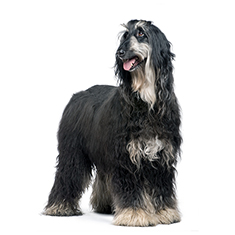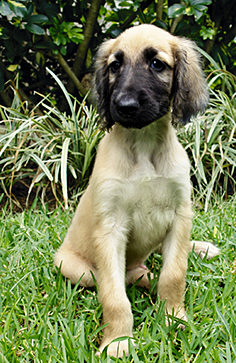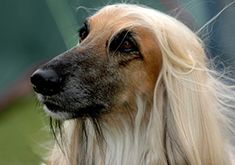Afghan Breed Guide
The beautiful Afghan Hound was originally bred, as its name implies, in Afghanistan, his long, silky coat providing protection against the cold mountain air. He is likely at least 5,000 to 8,000 years old, probably next in line after the Greyhound as the oldest dog. His original purpose was to hunt rabbits and gazelles by coursing them through the rugged terrain.
What does the Afghan look like?
The Afghan has been called the “king of dogs”, having a regal appearance. He stands 24 – 29 inches tall at the shoulders and weighs 45 – 60 pounds. The dog’s height at the shoulders is equivalent to the body length from chest to buttocks.

As a sighthound, the Afghan has especially sharp vision to enable him to detect the motion of his prey. The long, thin head allows both almond-shaped dark eyes to face forward, creating stereoscopic vision. His long legs and flexible spine allows him to chase his quarry with a very long stride. His deep chest contains a large heart and efficient lungs to help him sprint after prey, and his thin, wiry body is built for nothing but speed. His big, high hipbones and large feet help him traverse rocky terrain at a quick pace.
The coat of the Afghan may be any color, but white markings are less desirable, especially on the head. Many Afghans have a black mask on their face, adding to their regal appearance. Some of them, known as Mandarins, have long facial hair that resembles a Fu Manchu moustache. Regardless of his fur color, the Afghan’s eye rims, lips, and nose must always be dark.

The long hair is fine and silky, needing special care and consistent grooming. The fur on the head creates a long topknot, while the fur on the back is shorter, forming a characteristic saddle. The thin, nearly furless tail has a distinguishing curl at the end. In full gallop, the Afghan hound is something to behold. His hair streams gloriously in the wind, his head and tail held high.
Is the Afghan hound easy to train?
Some say these dogs are slow to learn, but mostly they are just independent. If they can’t see the value in following your commands, the simply won’t do it. In this respect, the breed acts more like a cat than a dog. A good trick is to catch the dog doing what you want him to do, then praise him as if he has discovered the cure for cancer, letting the dog think it was his idea in the first place.
This dog generally ranks low on conventional tests of dog intelligence, not because he isn’t smart, but because these tests are designed to measure how well a dog obeys basic commands. The Afghan, by nature of his breeding, works independently. In the hunt, he chases very fast prey. He cannot stand by and wait for commands from his master; rather, he must think for himself and live by his wits to assure his very survival.
Consistency and gentle training methods lead to the best results. Afghans don’t necessarily excel in obedience trials because of their apparent belief that they are royalty. However, by nature alone, these dogs make great lure-coursing contestants, often excelling at this popular sport.
Because he may choose to ignore your commands and because of his need for speed, this is a dog who absolutely requires a fenced-in area. Afghans have been clocked at over 40 miles per hour; they can jump across 20 feet and leap 7 feet straight up. At a trot which he can maintain for hours, the Afghan travels upwards of 10 miles per hour without even breathing hard. An ideal location to exercise your Afghan is on an outdoor tennis court where there is plenty of room for him to run around, and the fences are high enough to keep him contained.

When you are not actively exercising your Afghan, you may find that he is a bit of a couch potato. For some reason, probably because they know they shed, Afghans are drawn to upholstered furniture, where they will sprawl across the whole couch or steal your easy chair the minute you vacate it.
Afghans are accomplished counter-surfers, and their tall bodies may even be able to swipe things off the top of your refrigerator. They’ve been known to open drawers to get to whatever they have decided ought to be theirs. Careful puppy-proofing is required before you bring home this intelligent dog.
Is the Afghan good with children and other pets?
The Afghan’s suitability with children is not consistent from dog to dog. Some are great with children, while others will not put up with teasing, tail-pulling, and the other annoying things children are prone to do.
The Afghan will do well in a home with other large pets, but they generally think that smaller pets are prey. The prey drive is so strong in sighthounds that it is difficult to convince them that cats, bunnies, and even small dogs are not placed in the home simply for their hunting enjoyment. These dogs often served a protective function historically, with the ability to catch and bite through the spine of a leopard. The prey drive of any dog is tough to extinguish, so having an Afghan is likely not a chance you will want to take with your precious furry friends.
Early socialization is extremely important, as these dogs are large, strong, and stubborn. If you allow your Afghan to grow up without spending the proper amount of time learning about others, you will have an unmanageable, nearly feral adult dog. However, with patience and good training, you will have a comical, faithful friend. The Afghan’s suspicion of strangers can make him a great watchdog to protect your home, although he is not likely to attack intruders who aren’t scared off by his large size and deep bark.
How hard is it to groom an Afghan?

When you first bring home your Afghan puppy, he will have a smooth coat, which will gradually fall out over the first three years. At about 1 year, the long adult coat begins to come in, and the combination of the two coats can be a nightmare. Once the adult coat is fully developed, weekly baths and daily brushing are the norm. A snood or protective head covering may be used to keep the dog’s long ears and topknot out of his food and water.
The long coat serves an important protective function, trapping air to keep the dog cool. Clipping the coat in the summer really does not make the dog any cooler. Afghans shed their coats in the fall and spring, and after serious illnesses. In addition, unspayed females will shed after each heat cycle.
What health problems should I watch for?
Afghans are generally a healthy breed, living about 12 years. However, they are prone to allergies. They also have a relatively low tolerance to pain, which is why they are not great with rambunctious children. In addition, because of their low body fat percentage, they are very sensitive to anesthesia. Your vet must carefully monitor an Afghan undergoing surgery to prevent an overdose of anesthetic agents.
As with many large breeds, Afghans may develop hip dysplasia. Before purchasing a puppy, ask the breeder to show you certification from the Orthopedic Foundation for Animals (OFA), your guarantee that the parents’ hips have been checked and found free of defects.
Is this the right breed for me?
If you have three to four hours a month to spend grooming your dog and can tolerate a dog who is difficult to train, you may be interested in an Afghan hound. However, if you want a dog with low exercise needs who will acquiesce to your every wish, you may want to look elsewhere.
Doggies Den: Latest Articles
 Homemade Thanksgiving Treats for Your Dog
Homemade Thanksgiving Treats for Your Dog
NUTRITION We all want to include our dogs in our holiday celebrations, but hopefully, you're aware that sharing table scraps with your dog isn't always the best idea.
 Keeping Your Dog Safe during the Summer Months
Keeping Your Dog Safe during the Summer Months
HEALTH Summer is coming on fast, so it’s time to plan how you will keep your dog safe and healthy through the lazy, carefree, warm days.
 Vaccination Time Again-Keeping Your Puppy Healthy
Vaccination Time Again-Keeping Your Puppy Healthy
DOG HEALTH So you have your new puppy picked out. There are quite a few shots, treatments and examinations that will keep the newest member of your family healthy.
 Canine Thanksgiving Feast
Canine Thanksgiving Feast
NUTRITION With the wide variety of food at Thanksgiving dinner, chances are you'll want to give your dog something special, too. If you're contemplating what to feed your dog for the holiday, here is a guide to a great Canine Thanksgiving Feast.
 Dog Walking Tips Every Owner Should Know
Dog Walking Tips Every Owner Should Know
DOG FUN Walking your dog is not only crucial to keeping him healthy and happy, it strengthens the bond between your canine friend and his caregiver. There are a lot of obstacles out there. Don’t forget these simple tips to keep your walk fun and safe in the outside world.
 The Benefits of Physiotherapy for your Dog
The Benefits of Physiotherapy for your Dog
HEALTH The same techniques that physiotherapists use to treat a variety of injuries and conditions in humans have been adapted to suit animals with great success. Family pets, show dogs, and working dogs can all benefit greatly from physiotherapy. Dogs whose activities involve a lot of agility are especially susceptible to the types of problems that physiotherapy can address.
 The Decision- Adding a Dog to Your Family
The Decision- Adding a Dog to Your Family
FIRST TIME OWNERSBringing a dog into your family is a decision where many people don’t realize it’s magnitude until after they have the dog. There are a number of things that you need to research before you decide to purchase a dog, and it starts right in your own home.
 Bringing Your Dog Into Your New Baby's Life
Bringing Your Dog Into Your New Baby's Life
HEALTH Many believe that a dog and a new baby cannot happily coexist, so therefore the dog has to go. This is not necessarily the case.  A new baby does not mean you have to abandon your dog.

Doggies Den:
Most Popular Articles

Dog Pregnancy Symptoms
HEALTHIf you suspect your dog might be pregnant, check out part one in this series on pregnant dogs, where we cover pregnant dog symptoms.

Dog Birth
HEALTHIn the third article of our dog pregnancy series, we look at the wonderful, but messy, process of bringing newborn puppies into the world.

Indoor Dog Potties
DOG PRODUCTSIt's been a long day at work. You were so busy, you didn't even take time to eat a sandwich, let alone run home to let your dog out. You're on your way home, knowing the poor dog is crossing his or her legs by now, when your car breaks down, delaying you even further. Can't somebody make this easier?

Your Dog’s Digestive System
PHYSIOLOGYEver wonder why your dog eats so fast? Or why he eats gross things? Or why he gets sick to his stomach? Or why his waste stinks so bad? Some of these things are normal, some are not.

Canine Respiratory System
BREATHINGThe basic function of your dog's respiratory system is to bring oxygen in to and remove carbon dioxide from the body. Knowing the symptoms of respiratory diseases can help you help your stay healthy.

Shelter Dog Adoption Tips for Success
ADOPTION Are you intimidated by the prospect of "rescuing" a dog from a shelter? One reason that you may be wary of adopting a dog from a shelter is not knowing how to choose. Adopting a dog from a shelter can be a rewarding process, if you're prepared to do a reasonable amount of research.

Canine Urinary Tract Infections
SYMPTOMS AND TREATMENTDoes your dog seem to be having trouble relieving his or her bladder? Learn how to recognize the signs of urinary tract infections and how to treat them before they spread.

What to do for Dog Diarrhea
SYMPTOMS AND REMEDIESIf you have dogs in your house for any length of time, you have likely experienced at least one bout of dog diarrhea. Beyond the pain in the tuckus involved in cleaning up the mess, you should know what causes diarrhea, and when it's important to see the vet.

What to do for a Dog Bite
DOG BEHAVIOR Getting bitten by a dog can be scary, and you may be tempted to run around in circles for a while, trying to figure out what to do. Here's our guide to help you manage the situation.

Top Ten Tips for Living with a Senior Dog
DOG HEALTH Bringing home a new puppy is so exciting, but it doesn’t take all that long for your exuberant puppy to grow into a senior dog who may have special needs. Here are the doggies.com top ten tips for taking care of your companion who has been with you through so much.
